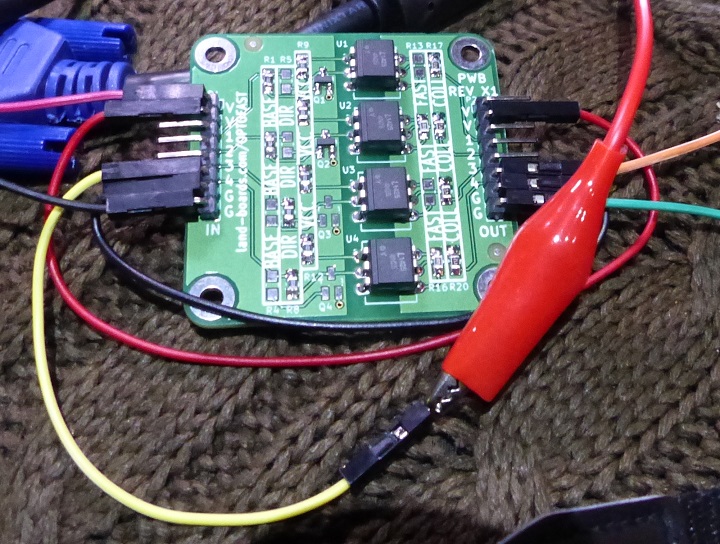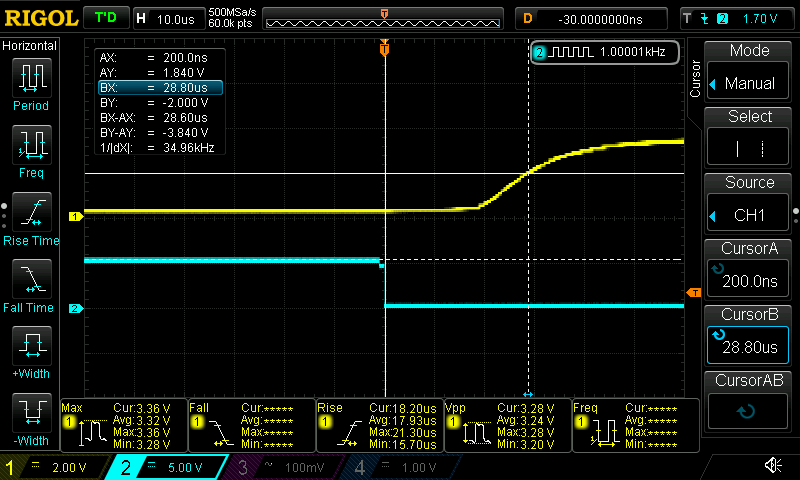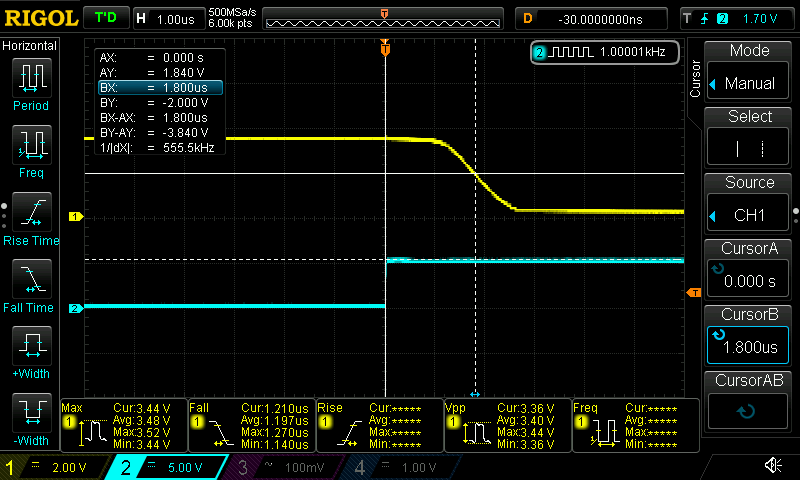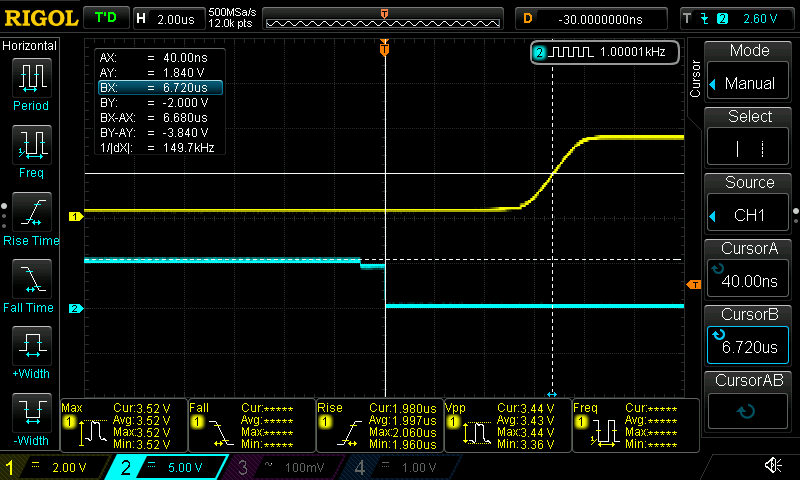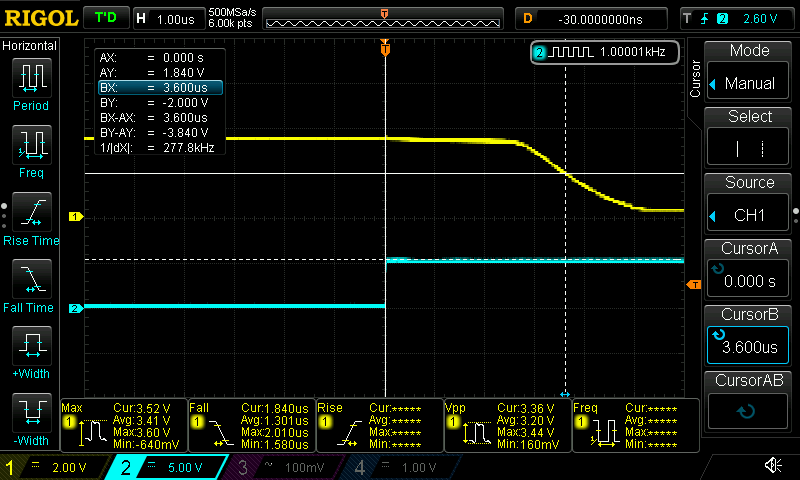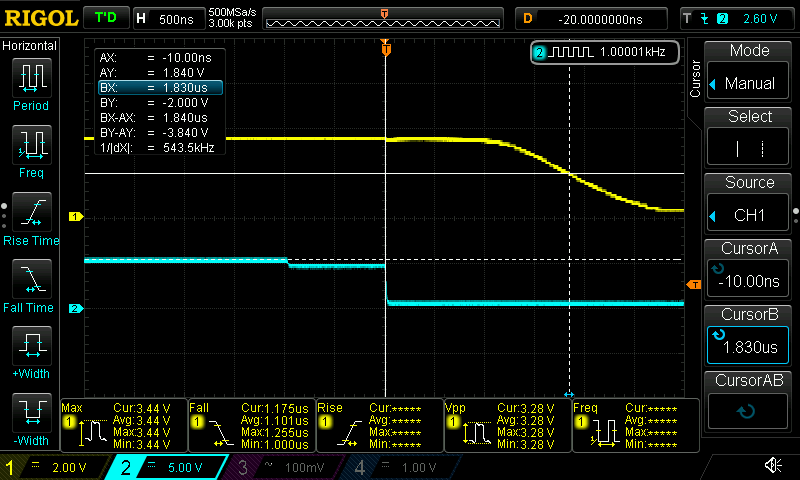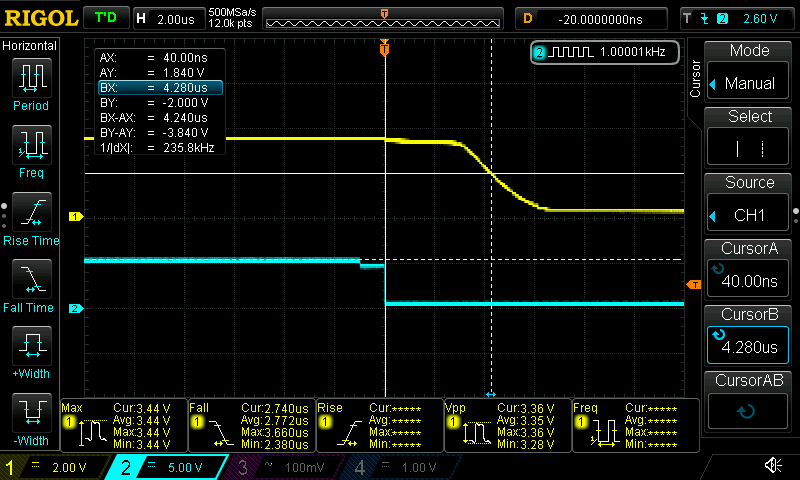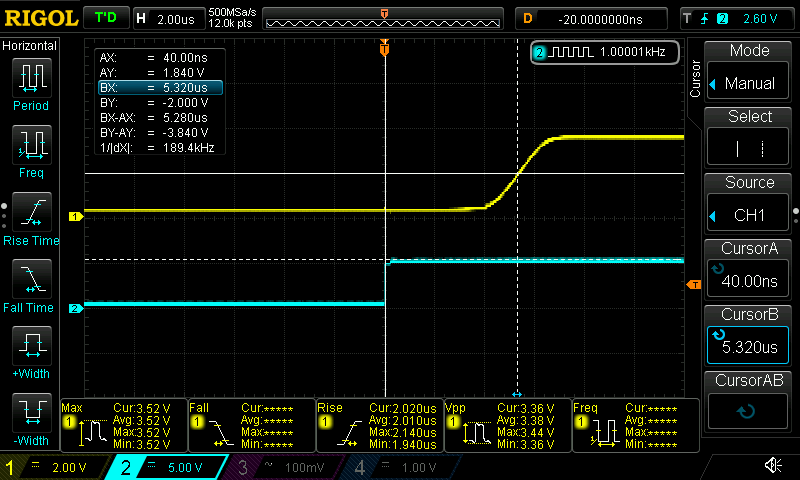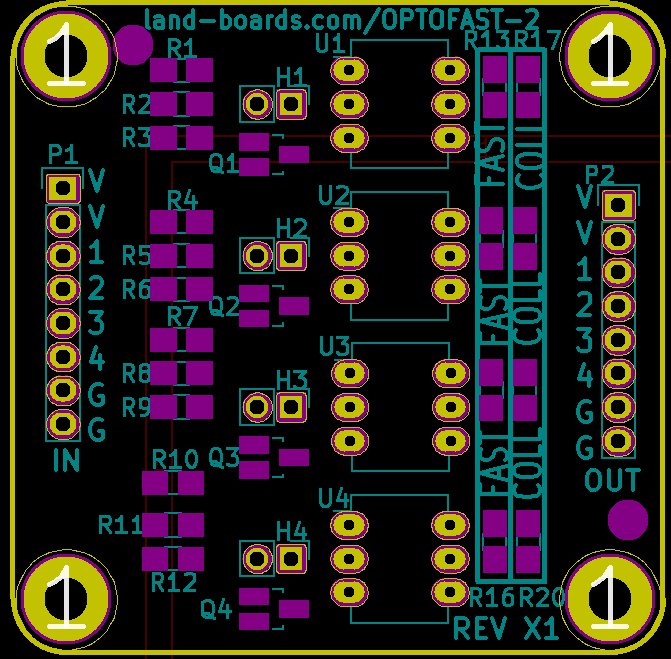Difference between revisions of "OPTOFAST"
Jump to navigation
Jump to search
Blwikiadmin (talk | contribs) |
Blwikiadmin (talk | contribs) |
||
| Line 25: | Line 25: | ||
* 49x49mm | * 49x49mm | ||
* (4) 4-40 mounting holes | * (4) 4-40 mounting holes | ||
| + | |||
| + | == Schematic (One channel) == | ||
| + | |||
| + | [[File:OPTOFAST-2-Schematic-TransIn.PNG]] | ||
| + | |||
| + | * U1 represents U1-U4 (channels 1-4) | ||
| + | * Q1 represents Q1-Q4 (channels 1-4) | ||
| + | * R1 (VCC) represents R1,R4,R7,R10 (channels 1-4) | ||
| + | * R2 (DIR) represents R2,R5,R8,R11 (channels 1-4) | ||
| + | * R3 (BASE) represents R3,R6,R8,R12 (channels 1-4) | ||
| + | * R13 (FAST) represents R13-R16 (channels 1-4) | ||
| + | * R17 (COLL) represents R17-R20 (channels 1-4) | ||
| + | |||
| + | === Input Options === | ||
| + | |||
| + | * Refer to schematic for impact of options | ||
| + | |||
| + | ==== Use Input Transistor - Standard Option ==== | ||
| + | |||
| + | * Common VCC in option | ||
| + | * Install transistor Q1 | ||
| + | * R1 = 150 | ||
| + | ** LED current is 3.5V/150 Ohms = 23 mA | ||
| + | ** CTR = .20, 4.7 mA | ||
| + | * R2 = Do not populate | ||
| + | * R3 = 10K | ||
| + | ** Base drive ~ (Vin - 0.7V)/R3 | ||
| + | ** At 5V drive this is 4.3V/R3 | ||
| + | *** Using R3=10K at 5V this is 0.43mA Ib | ||
| + | *** HFE (MMBT3904) = 100 min | ||
| + | *** That is potentially 43 mA (in the switching range of the transistor) | ||
| + | **** Collector resistor and LED voltage drop are current limiter | ||
| + | ** At 3.3V drive this is (3.3-0.7)/10K = .26mA Ib | ||
| + | *** HFE = 100 min | ||
| + | *** That is 26 mA (in the switching range of the transistor) | ||
| + | * H1 do not short | ||
| + | |||
| + | === Direct Drive - Special Option === | ||
| + | |||
| + | [[File:OPTOFAST-2-Schematic-Direct.PNG]] | ||
| + | |||
| + | * Do not install Q1 | ||
| + | * Do not install R1 | ||
| + | * R2 = 150 | ||
| + | ** Input current = LED current = 3.5V/150 Ohms = 23 mA | ||
| + | * Do not install R3 | ||
| + | * Do not install Q1 | ||
| + | * Short H1 | ||
| + | |||
| + | == Output Options == | ||
| + | |||
| + | === Standard Output === | ||
| + | |||
| + | * R17 = 1.2K | ||
| + | ** 5V/1.2K = 4.1mA of output transistor B-E current | ||
| + | ** Leaves 4.7-4.1 mA = 600 uA of output low current | ||
| + | |||
| + | === Open Collector Output - Special Option === | ||
| + | |||
| + | * Do not install R17 | ||
| + | |||
| + | === Fast Option - Standard === | ||
| + | |||
| + | * R13 = 20K (empirically determined from the scope eye) | ||
| + | |||
| + | == Connectors == | ||
| + | |||
| + | === P1 - Input === | ||
| + | |||
| + | 8-pin, right angle, 0.1" pitch | ||
| + | |||
| + | # Vcc (In) | ||
| + | # Vcc (In) | ||
| + | # IN 1 | ||
| + | # IN 2 | ||
| + | # IN 3 | ||
| + | # IN 4 | ||
| + | # GND (In) | ||
| + | # GND (In) | ||
| + | |||
| + | === P2 - Output === | ||
| + | |||
| + | 8-pin, right angle, 0.1" pitch | ||
| + | |||
| + | # Vcc (Out) | ||
| + | # Vcc (Out) | ||
| + | # OUT 1 | ||
| + | # OUT 2 | ||
| + | # OUT 3 | ||
| + | # OUT 4 | ||
| + | # GND (Out) | ||
| + | # GND (Out) | ||
| + | |||
| + | == Test Card Measurements == | ||
| + | |||
| + | [[File:OptoFast-TestSetup-720px.jpg]] | ||
| + | |||
| + | === Setup=== | ||
| + | |||
| + | * Goal was to determine the performance of the OPTOFAST card | ||
| + | * 5V operation | ||
| + | * Same 5V input/output power supply | ||
| + | * Each of the channels were configured uniquely/individually | ||
| + | * MHS-5200A - Digital DDS Dual-channel Signal Generator | ||
| + | ** 1 KHz square wave | ||
| + | ** 5V signal level | ||
| + | * Single channel checked at a time | ||
| + | * Oscilloscope | ||
| + | ** Rigol DS1054Z | ||
| + | ** 50 MHz | ||
| + | ** Ultra Sigma software used for screen captures | ||
| + | |||
| + | === Notes === | ||
| + | |||
| + | * Note that the input buffer transistor inverts the signal | ||
| + | * Built a card that has four different configurations | ||
| + | * Options | ||
| + | ** Fast/Slow | ||
| + | ** Direct drive input LED/Transistor Buffered input | ||
| + | |||
| + | === Test Results=== | ||
| + | * Channel Fast/Slow TransBuff/Direct Input Rise/Fall Time(uS) | ||
| + | 1 Slow Transistor Buffer Fall 28.6 | ||
| + | 1 Slow Transistor Buffer Rise 1.8 | ||
| + | 2 Fast Transistor Buffer Fall 6.68 | ||
| + | 2 Fast Transistor Buffer Rise 3.6 | ||
| + | 3 Slow Direct Input Fall 1.84 | ||
| + | 3 Slow Direct Input Rise 27.4 | ||
| + | 4 Fast Direct Input Fall 4.24 | ||
| + | 4 Fast Direct Input Rise 5.28 | ||
| + | </pre> | ||
| + | |||
| + | === Observations === | ||
| + | |||
| + | * Input Transistor effect | ||
| + | ** Value of the input transistor is that does not require a high drive level input | ||
| + | ** The input transistor has very little effect on speed - a couple hundred nS slower than direct drive | ||
| + | ** The inversion effect of the input transistor moves the "slow" time around | ||
| + | ** Downside of the input transistor is that it has less noise immunity since the transistor turns on at 0.6V vs the internal LED in the optocoupler at 1.5V? | ||
| + | * Output "fast" circuit | ||
| + | ** Output pullup of 4.7K affects the rise time of the output | ||
| + | ** The fast is faster, but not in some conditions | ||
| + | ** Average of rise/fall is better | ||
| + | ** Transistor buffer instance rise input is slower with the fast output | ||
| + | ** Fast output helps the output rise time | ||
| + | |||
| + | === Ch1-Slow-NPNBuffer-InFall === | ||
| + | |||
| + | [[File:Ch1-Slow-NPNBuffer-InFall.png]] | ||
| + | |||
| + | === Ch1-Slow-NPNBuffer-InRise === | ||
| + | |||
| + | [[File:Ch1-Slow-NPNBuffer-InRise.png]] | ||
| + | |||
| + | === Ch2-Fast-NPNBuffer-InFall === | ||
| + | |||
| + | [[File:Ch2-Fast-NPNBuffer-InFall.png]] | ||
| + | |||
| + | === Ch2-Fast-NPNBuffer-InRise === | ||
| + | |||
| + | [[File:Ch2-Fast-NPNBuffer-InRise.png]] | ||
| + | |||
| + | === Ch3-Slow-Direct-InFall === | ||
| + | |||
| + | [[File:Ch3-Slow-Direct-InFall.png]] | ||
| + | |||
| + | === Ch3-Slow-Direct-InRise === | ||
| + | |||
| + | [[File:Ch3-Slow-Direct-InRise.png]] | ||
| + | |||
| + | === Ch4-Fast-Direct-InFall === | ||
| + | |||
| + | [[File:Ch4-Fast-Direct-InFall.png]]] | ||
| + | |||
| + | === Ch4-Fast-Direct-InRise === | ||
| + | |||
| + | [[File:Ch4-Fast-Direct-InRise.png]] | ||
| + | |||
| + | == Layout == | ||
| + | |||
| + | [[File:OPTOFAST-2 PWB.PNG]] | ||
Revision as of 21:36, 13 March 2022
Contents
OPTOFAST - 4 Channel Optocoupler Card
See our other Optocoupler cards
- OPTOFAST-2 - Speed improved 4 channel optocoupler card - Suggested replacement for this card
- OPTOSMALL - Four channel optocoupler card
- OPTOOUT8-I2C - Eight channel optocoupler card - I2C interface
- OPTOUSB - Optically coupled USB to FTDI interface
- OPTOFASTBI - Two Optos in Two Directions
Features
- Opto-Isolator card
- 4-Channels
- 4N25 Optoisolators
- Input /Output isolation
- Transistor driver for Opto LED reduces required drive from 10 mA to under 500 uA
- Input channels share their own common VCC/Ground
- Output channels share their own common Vcc/Ground
- 8-pin header for input
- 8-pin header for output
- Configuration Options (Speed enhanced, Bypass Input transistors, Remove Output collector resistors)
- 49x49mm
- (4) 4-40 mounting holes
Schematic (One channel)
- U1 represents U1-U4 (channels 1-4)
- Q1 represents Q1-Q4 (channels 1-4)
- R1 (VCC) represents R1,R4,R7,R10 (channels 1-4)
- R2 (DIR) represents R2,R5,R8,R11 (channels 1-4)
- R3 (BASE) represents R3,R6,R8,R12 (channels 1-4)
- R13 (FAST) represents R13-R16 (channels 1-4)
- R17 (COLL) represents R17-R20 (channels 1-4)
Input Options
- Refer to schematic for impact of options
Use Input Transistor - Standard Option
- Common VCC in option
- Install transistor Q1
- R1 = 150
- LED current is 3.5V/150 Ohms = 23 mA
- CTR = .20, 4.7 mA
- R2 = Do not populate
- R3 = 10K
- Base drive ~ (Vin - 0.7V)/R3
- At 5V drive this is 4.3V/R3
- Using R3=10K at 5V this is 0.43mA Ib
- HFE (MMBT3904) = 100 min
- That is potentially 43 mA (in the switching range of the transistor)
- Collector resistor and LED voltage drop are current limiter
- At 3.3V drive this is (3.3-0.7)/10K = .26mA Ib
- HFE = 100 min
- That is 26 mA (in the switching range of the transistor)
- H1 do not short
Direct Drive - Special Option
- Do not install Q1
- Do not install R1
- R2 = 150
- Input current = LED current = 3.5V/150 Ohms = 23 mA
- Do not install R3
- Do not install Q1
- Short H1
Output Options
Standard Output
- R17 = 1.2K
- 5V/1.2K = 4.1mA of output transistor B-E current
- Leaves 4.7-4.1 mA = 600 uA of output low current
Open Collector Output - Special Option
- Do not install R17
Fast Option - Standard
- R13 = 20K (empirically determined from the scope eye)
Connectors
P1 - Input
8-pin, right angle, 0.1" pitch
- Vcc (In)
- Vcc (In)
- IN 1
- IN 2
- IN 3
- IN 4
- GND (In)
- GND (In)
P2 - Output
8-pin, right angle, 0.1" pitch
- Vcc (Out)
- Vcc (Out)
- OUT 1
- OUT 2
- OUT 3
- OUT 4
- GND (Out)
- GND (Out)
Test Card Measurements
Setup
- Goal was to determine the performance of the OPTOFAST card
- 5V operation
- Same 5V input/output power supply
- Each of the channels were configured uniquely/individually
- MHS-5200A - Digital DDS Dual-channel Signal Generator
- 1 KHz square wave
- 5V signal level
- Single channel checked at a time
- Oscilloscope
- Rigol DS1054Z
- 50 MHz
- Ultra Sigma software used for screen captures
Notes
- Note that the input buffer transistor inverts the signal
- Built a card that has four different configurations
- Options
- Fast/Slow
- Direct drive input LED/Transistor Buffered input
Test Results
- Channel Fast/Slow TransBuff/Direct Input Rise/Fall Time(uS)
1 Slow Transistor Buffer Fall 28.6 1 Slow Transistor Buffer Rise 1.8 2 Fast Transistor Buffer Fall 6.68 2 Fast Transistor Buffer Rise 3.6 3 Slow Direct Input Fall 1.84 3 Slow Direct Input Rise 27.4 4 Fast Direct Input Fall 4.24 4 Fast Direct Input Rise 5.28
Observations
- Input Transistor effect
- Value of the input transistor is that does not require a high drive level input
- The input transistor has very little effect on speed - a couple hundred nS slower than direct drive
- The inversion effect of the input transistor moves the "slow" time around
- Downside of the input transistor is that it has less noise immunity since the transistor turns on at 0.6V vs the internal LED in the optocoupler at 1.5V?
- Output "fast" circuit
- Output pullup of 4.7K affects the rise time of the output
- The fast is faster, but not in some conditions
- Average of rise/fall is better
- Transistor buffer instance rise input is slower with the fast output
- Fast output helps the output rise time



